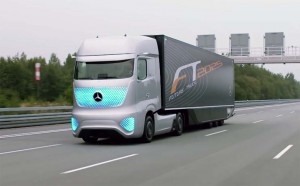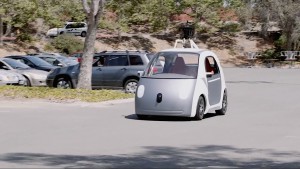
The Mercedes Future Truck could be the prototype for a future in which even truck drivers are replaced by automation.
Hoping to calm criticism, ride-hailing service Uber this month announced that it plans to have at least 1 million women drivers in place by the end of the decade.
But those jobs might be short-lived. Uber and rival Lyft are already giving serious thought to turning to fully driverless vehicles – as is Google, the tech giant already putting together a fleet of autonomous vehicles that will be used in a test program near its Silicon Valley headquarters.
Over the last quarter century we’ve seen a sharp shift in manufacturing where large numbers of traditional jobs have been replaced by machine. But a new study by Oxford University warns that as much as 47% of all U.S. jobs could be automated out of existence over the next 20 years.
The range of jobs that are vulnerable may come as a surprise, robots or simply algorithms taking over everything from customer service to table service at restaurants. Several technology firms are even developing automated news services that take raw data input – say, an automaker’s earnings report – and punch out neat and tidy stories.
(As part of pilot program, Volvo planning to put 100 autonomous vehicles into motorists’ hands. Click Here for the full story.)
Some of the biggest cuts could come in the auto industry and in jobs related to motor vehicles, stressed Michael Osbourne, a co-director of the Oxford Martin Programme on Technology and Employment. The group used its own research algorithm and U.S. Bureau of Statistics data as the basis of the study.
Of course, automation has long been a force in the auto industry. And, in early years, it helped create jobs by helping pioneers like Henry Ford bring the cost of a car down to the point where it could be affordable to the average American. By the 1970s, it was widely estimated, one in seven U.S. jobs was linked with the auto industry, much of that work along the assembly line.
But that began to shift with the arrival of robots and ever-smaller and more powerful computers. Assembly lines like the one at the Ford Rouge complex in Dearborn, Michigan, once would require as many as 5,000 workers to turn out perhaps 200,000 cars annually. Today, some plants are rolling out almost twice that volume with less than half the workforce.
And every new factory that comes along sees an increase in automation. Not just in the U.S., either. Volkswagen this month announced plans for a $1.1 billion expansion of its big factory in Puebla, Mexico, adding a new level of robotics in a factory that traditionally was content to get by with cheap local labor. The same trend is happening in China as wages there begin to rise.
The automation revolution is set to extend beyond the factory, emphasizes the new Oxford study. We’ve already begun to see that in the office, where word processors have replaced the secretarial pool, and desktop computers trim the need for accountants and other number-crunchers.
What’s next? “Forklift drivers, truck drivers, agricultural vehicle drivers,” Osbourne noted during a conference in which the report’s findings were revealed. “Those jobs could be gone very soon.”
Indeed, a number of plants already use autonomous guided vehicles, or AGVs, to deliver parts to the assembly line. That could expand when the devices become smarter, no longer dependent upon installing tracks or guide tape on the factory floor.
Then there’s the long-haul. Mercedes-Benz recently unveiled a prototype autonomous 18-wheeler that could foreshadow a day when those trucks vying for space on the Interstate are driverless. That’s appealing to fleet operators who already face a shortage of human drivers. They’d also be able to keep their rigs running 24/7, something now impossible due to federal limits on the number of hours humans can stay behind the wheel.
Even local delivery services could be impacted. Consider Amazon’s interest in using drones.
(Will Apple and Google be allies or adversaries of traditional automakers? Click Here for the story.)
And as for taxis and ride-hailing services, “The Uber experience is expensive because it’s not just the car but the other dude in the car,” Uber CEO Travis Kalanick said during a 2014 technology conference, indicating Uber would like to find a way to switch to autonomous vehicles. “When there’s no other dude in the car, the cost (of riding with Uber) gets cheaper than owning a vehicle.”
How much further might this go? In his very first book, “Player Piano,” author Kurt Vonnegut wrote about a world in which virtually everything was automated. And most of the displaced workers were assigned to the “Wreaks and Wrecks” squads. They’d spend one day tearing apart roads, rebuilding them the next day.
The good news, as it were, was that even the folks who designed all the automation in this dystopian world were eventually sent out to pasture when the machines got smart enough to design their own replacements.
(Automakers struggle to address issues of privacy in high-tech cars. Click Herefor the story.)


Robotics has been eliminating many jobs in the auto and other manufacturing industries for years. At least a decade ago Porsche, VW, BMW and other auto makers started employing robots for difficult or unfriendly manufacturing tasks suck as welding, windshield installations, etc. The Euro companies also use autonomous parts delivery machines to supply assembly line workers with specific components per car as most cars are built to order. Now days there is much robotic use and often it performs the job more accurately and consistently.
The good news is if you are smart you can be a robot designer, engineer or maintenance tech as this field is growing rapidly. Robotics however are not going to simply replace truck drivers.
When autonomous cars are actually ready for use, it would still take a realistic infrastructure to properly support them. That means more jobs to build the autonomous vehicles and the infrastructure. So in many ways most workers won’t be replaced, they will be displaced because they will need to be retrained in other skills or find a different job. In reality most people in the workforce today will not be displaced as it will be decades before autonomous vehicles in any reasonable numbers exist in actual operation.
This is very outdated news …
This news may be outdated, but still presents a terrible problem. The population continues to grow, along with job de-population. Not everyone will be smart enough or skilled enough to work on and with automation, robotics, whatever. Robots will program and repair robots. The factory of the future will have maybe a dozen humans. Future planners are increasingly skeptical human resources will be necessary for “work.” This may be a huge problem within a generation.